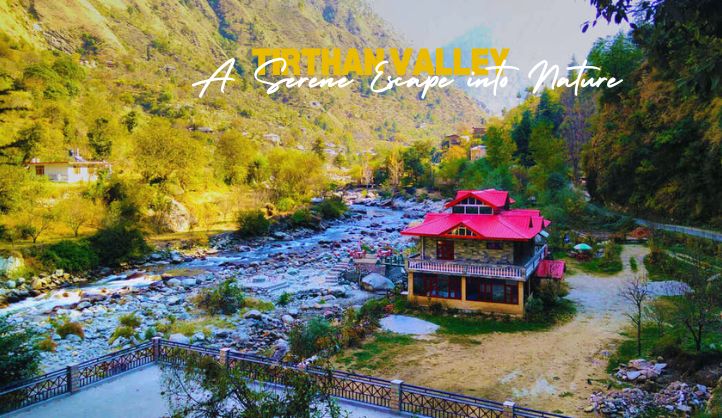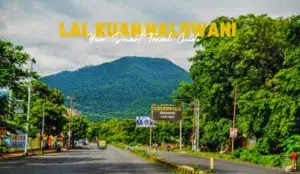In the Kullu district of Himachal Pradesh, Tirthan Valley is a hidden gem that promises an escape from the bustling city life. Known for its pristine beauty, crystal-clear rivers, dense forests, and snow-capped peaks, this valley is an ideal destination for nature lovers, trekkers, and adventure enthusiasts alike. Whether you seek solitude, adventure, or simply a rejuvenating retreat amidst nature, Tirthan Valley offers it all.
Tirthan Valley derives its name from the Tirthan River, which flows serenely through the region. The valley is part of the larger Great Himalayan National Park (GHNP), a UNESCO World Heritage Site, which is renowned for its biodiversity and scenic landscapes. Despite its growing popularity, Tirthan Valley retains its untouched charm, making it a perfect destination for those seeking peace and tranquility.
Top Attractions
1. Great Himalayan National Park (GHNP)
A UNESCO World Heritage Site, GHNP is the crown jewel of Tirthan Valley. Spread across 1,171 square kilometers, the park is home to rare flora and fauna, including the elusive snow leopard, Himalayan tahr, and blue sheep. Visitors can explore the park through guided treks and nature walks that offer a glimpse into its rich biodiversity.
2. Tirthan River
The Tirthan River is the lifeline of the valley, offering opportunities for fishing, riverside picnics, and leisurely walks along its banks. The river’s pristine waters are also ideal for trout fishing, making it a favorite spot for anglers.
3. Jalori Pass
Situated at an altitude of 10,800 feet, Jalori Pass is a gateway to breathtaking views of the Himalayas. A short trek from the pass leads to Serolsar Lake, a serene high-altitude lake surrounded by dense forests. Another trail takes you to the Raghupur Fort, an ancient fort offering panoramic views of the surrounding mountains.
4. Chhoie Waterfall
A short trek through dense forests and picturesque trails leads to the Chhoie Waterfall, a hidden gem in the valley. The cascading waters and tranquil surroundings make it a perfect spot for nature lovers and photographers.
5. Gushaini Village
Gushaini is a quaint village that serves as the base for many treks and activities in Tirthan Valley. Known for its rustic charm, the village offers a glimpse into the simple yet vibrant lifestyle of the locals.
Adventure Activities
1. Trekking
Tirthan Valley is a trekker’s paradise, with trails ranging from easy walks to challenging routes. Popular treks include the Rolla Trek, Sharchi Village Trek, and the Serolsar Lake Trek. Each trek offers unique experiences, from dense forests and alpine meadows to panoramic mountain views.
2. Fishing and Angling
The Tirthan River is renowned for trout fishing, with several designated spots for anglers. Permits are required, but the experience of catching a fish in the pristine waters is well worth the effort.
3. Camping
Camping by the riverside or in the lap of the mountains is a popular activity in Tirthan Valley. Several camping sites and homestays offer tents and basic amenities, ensuring a comfortable stay amidst nature.
4. Rock Climbing and Rappelling
For adventure enthusiasts, Tirthan Valley offers opportunities for rock climbing and rappelling. These activities are usually organized by local operators and are suitable for both beginners and experienced climbers.
5. Bird Watching
The valley’s rich biodiversity makes it a haven for bird watchers. The GHNP and surrounding areas are home to a variety of bird species, including Himalayan monals, woodpeckers, and bulbuls.
Cultural Experiences in Tirthan Valley
1. Local Villages
Visiting villages like Gushaini, Nagini, and Sharchi allows travelers to experience the local culture and traditions. The warm hospitality of the locals and their simple way of life are sure to leave a lasting impression.
2. Traditional Cuisine
Savoring the local Himachali cuisine is a must during your visit. Dishes like Siddu (steamed bread with stuffing), Dham (a traditional feast), and Chana Madra (chickpea curry) are popular delicacies. Many homestays and small eateries serve authentic regional food prepared with fresh, locally sourced ingredients.
Best Time to Visit
Tirthan Valley can be visited throughout the year, but each season offers a unique experience:
- Spring (March to May): The valley comes alive with blooming flowers and pleasant weather, making it an ideal time for trekking and camping.
- Summer (June to August): While the monsoon brings occasional rains, the valley remains lush and vibrant. Be cautious of slippery trails.
- Autumn (September to November): The post-monsoon period offers clear skies, crisp air, and stunning views of the Himalayas.
- Winter (December to February): The valley transforms into a winter wonderland, with snow-covered landscapes offering opportunities for snow trekking and cozy stays.
How to Reach Tirthan Valley
1. By Road
Tirthan Valley is well-connected by road. The nearest major town is Aut, located on the Chandigarh-Manali Highway (NH3). From Aut, a 26-kilometer drive takes you to the valley. Buses and taxis are available from Aut to Tirthan.
2. By Air
The nearest airport is Bhuntar Airport, located about 50 kilometers from Tirthan Valley. Regular flights connect Bhuntar to Delhi and other major cities. From the airport, taxis can be hired to reach the valley.
3. By Train
The nearest railway station is in Chandigarh, approximately 270 kilometers from Tirthan Valley. From Chandigarh, travelers can hire taxis or take buses to reach the valley.
Where to Stay in Tirthan Valley
Tirthan Valley offers a range of accommodation options, including homestays, guesthouses, and boutique resorts. Popular options include:
- Riverside Homestays: Offering stunning views and warm hospitality, these are perfect for those seeking a tranquil retreat.
- Eco-Lodges: Ideal for eco-conscious travelers, these lodges focus on sustainable practices and offer a close-to-nature experience.
- Camping Sites: For adventure enthusiasts, camping by the river or in the forests is a memorable experience.
Travel Tips for Tirthan Valley
- Pack Accordingly: Depending on the season, pack warm clothes, sturdy trekking shoes, and rain gear.
- Permits: If you plan to visit the Great Himalayan National Park or go fishing, ensure you have the necessary permits.
- Connectivity: Internet and mobile connectivity can be patchy in some areas, so plan accordingly.
- Eco-Friendly Travel: Respect the environment by avoiding littering and using eco-friendly products.
- Local Guidance: Hire local guides for treks and activities to ensure safety and gain insights into the region.
Conclusion
Tirthan Valley is a sanctuary for those seeking a blend of adventure, tranquility, and natural beauty. With its unspoiled landscapes, rich biodiversity, and warm hospitality, it offers a unique experience that leaves visitors rejuvenated and inspired. Whether you’re planning a solo trip, a family vacation, or an adventure-packed getaway, Tirthan Valley promises memories that will last a lifetime. So pack your bags, embark on this magical journey, and let the serene charm of Tirthan Valley captivate your soul.
FAQs About Tirthan Valley
1. What is the best time to visit Tirthan Valley?
The best time to visit Tirthan Valley depends on your preferences:
- Spring (March to May): Ideal for trekking and exploring nature.
- Autumn (September to November): Offers clear skies and stunning views.
- Winter (December to February): Perfect for experiencing snowfall.
2. How can I reach Tirthan Valley?
Tirthan Valley can be reached by:
- Road: Drive to Aut on the Chandigarh-Manali Highway and take a 26-kilometer detour.
- Air: Fly to Bhuntar Airport, 50 km away, and hire a taxi.
- Train: The nearest railway station is Chandigarh, about 270 km away.
3. Are there adventure activities available in Tirthan Valley?
Yes, Tirthan Valley offers a variety of activities such as:
- Trekking to Serolsar Lake and Raghupur Fort.
- Fishing in the Tirthan River.
- Camping by the riverside or in the mountains.
- Bird watching and nature photography.
4. What are some must-visit attractions in Tirthan Valley?
Some popular attractions include:
- Great Himalayan National Park
- Jalori Pass and Serolsar Lake
- Chhoie Waterfall
- Gushaini Village
5. What kind of accommodations are available in Tirthan Valley?
You can choose from:
- Riverside homestays with local hospitality.
- Eco-lodges for sustainable living.
- Camping sites for adventure enthusiasts.
6. Is Tirthan Valley suitable for a family trip?
Absolutely! Tirthan Valley offers activities and attractions for all age groups, from nature walks and cultural experiences to riverside picnics and cozy stays in homestays.





